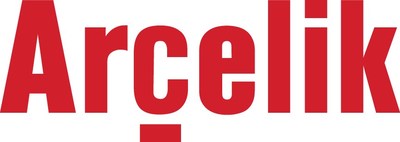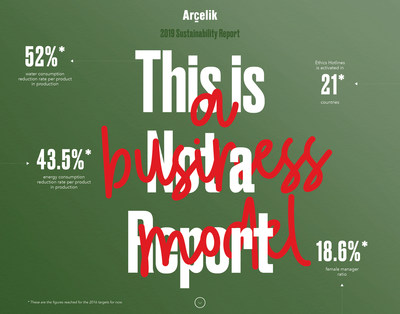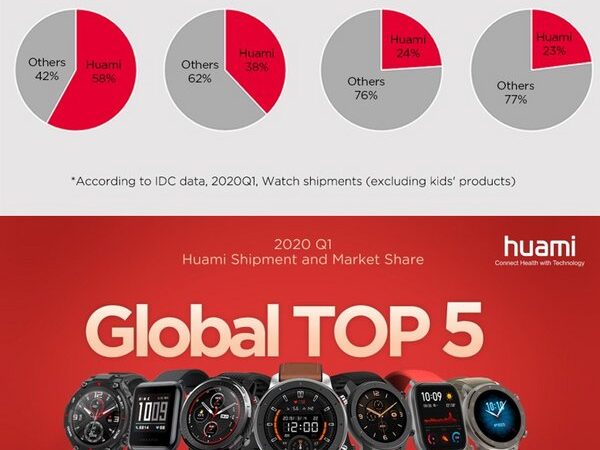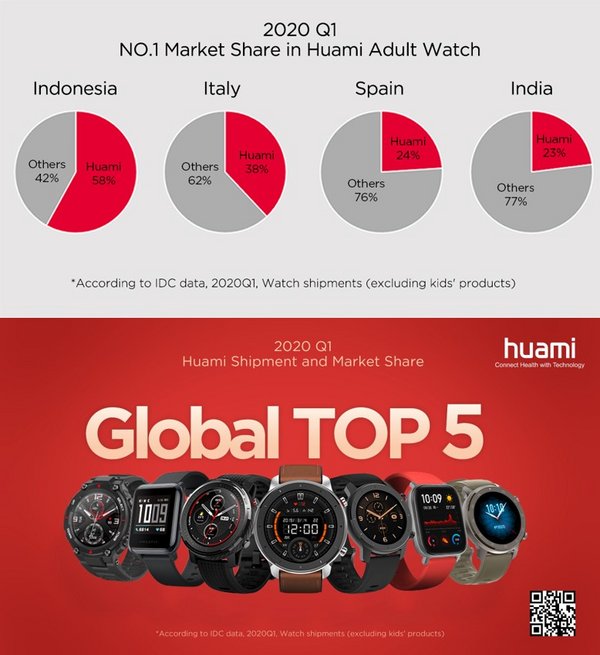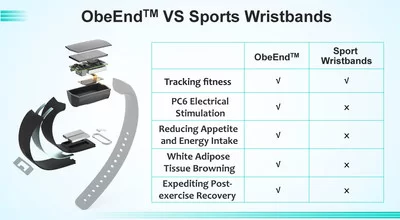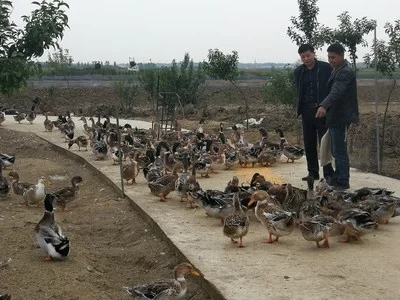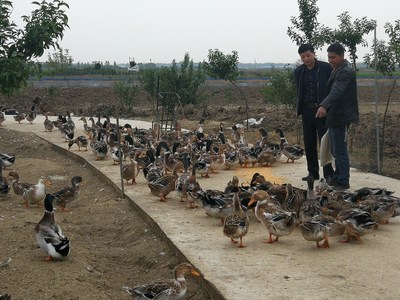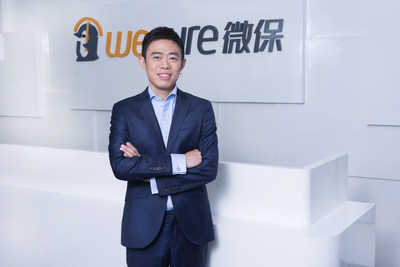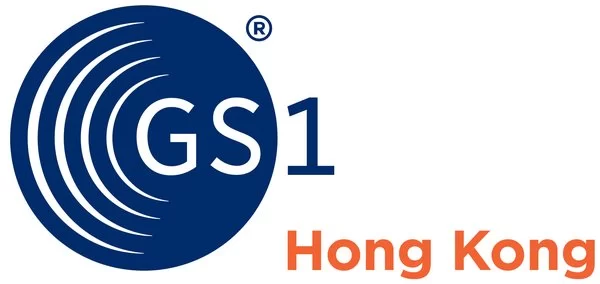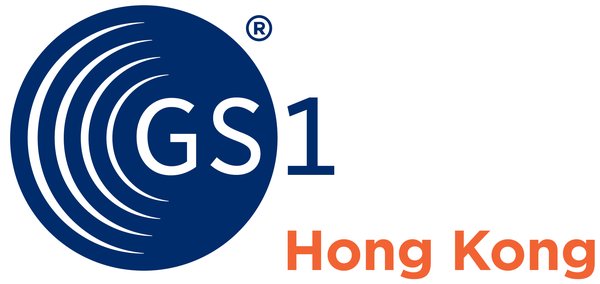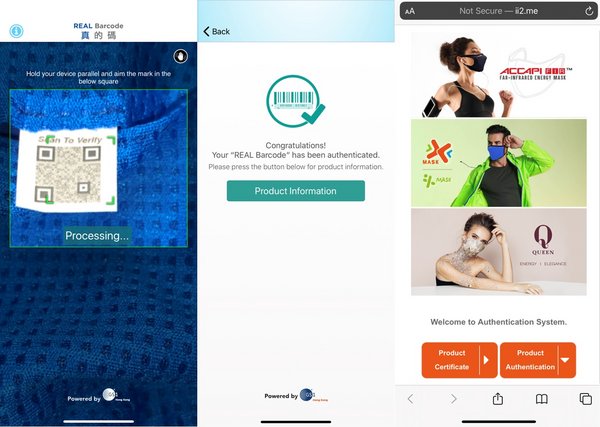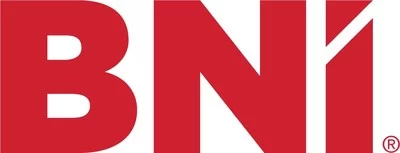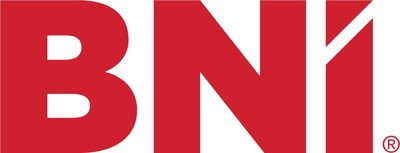HONG KONG, June 5, 2020 /PRNewswire/ — Despite the heavy blow of COVID-19 on business, many local companies find new opportunities in producing and trading anti-epidemic products to battle against the pandemic, and ride out the challenges by quickly transforming and diversifying their businesses.
 Consumers can verify whether a product is genuine simply by scanning the REAL QR Code with “REAL Barcode” mobile app. Consumers can obtain immediate results from REAL Barcode and verify that the product is real. Consumers can access to detailed product information after verifying the product.
Consumers can verify whether a product is genuine simply by scanning the REAL QR Code with “REAL Barcode” mobile app. Consumers can obtain immediate results from REAL Barcode and verify that the product is real. Consumers can access to detailed product information after verifying the product.
Since the outbreak of COVID-19 in February, more than 85 companies have applied for the global barcode from GS1 Hong Kong (GS1 HK). Barcodes not only enable the companies to sell locally and globally, online & offline, but also help them enhance brand value. Among which a brand goes further to adopt GS1 HK’s patented authentication solution to safeguard consumers’ health and build their trust.
Enabling Omni-channel Commerce with Barcodes
GS1 Hong Kong has sped up the barcode application process for more than 85 companies supplying anti-epidemic items, so their products can roll out to market faster to aid the city’s fight against COVID-19. Among the newly registered companies, 32 of the them are manufacturers, and the majority are making face masks for local market. Li Hung International Company Limited, a garment manufacturer of 20 years, is one of them. They started mask production in their dust-free workshop in early May, under the company "Hong Kong Mask Co. Ltd." newly registered in February. They are now offering EN14683 Type II certified (BFE>99%) disposable face masks, supplying the city with an estimated 2.5 million pieces per month.
Their spokesperson acknowledges that barcodes help them "inside and out". Externally, the barcode prefix "489" supports them sell in both domestic and overseas markets, as it’s a prerequisite for products to be listed on retail stores and e-commerce platforms like Amazon, and worldwide consumers would recognise and be assured of the "Made in Hong Kong" quality. Internally, barcodes help in a number of ways in terms of inventory management, pick & pack, distribution and sales management, etc.
"GS1 international barcode is every product’s ID. It allows products to be uniquely identified, and serves as the basis for authentication and verification," said Anna Lin, Chief Executive of GS1 Hong Kong. "Besides widely used in physical stores, leading e-commerce platforms like Alibaba, Amazon, eBay and Google also require or call for GS1 product standards identification, Global Trade Item Number (GTIN), to be used, which facilitate consumers to easily search for products, providing detailed, accurate & reliable information, building trust in the heads & minds of consumers."
"489" Barcode on Mask Package Increases Consumer Confidence
There are some dishonest merchants who have taken advantage of the circumstances by selling unscrupulous masks, and it’s often hard to distinguish the reliable ones from the wide array of masks in the market. Barcode prefix (the first 3 digits of a barcode) can give a hint to consumers about the products’ owner origin, as it indicates the area in which the company is registered. For example, barcode prefix "489" represents companies registered in Hong Kong, "471" stands for Taiwan, "450-459" and "490-499" means Japan.
GS1 Hong Kong members can upload their product information onto GS1 HK’s BarcodePlus, a product information repository, for free, which is accessible by potential buyers or consumers from all over the world. The platform helps increase product visibility and raise awareness among consumers.
Simply by entering the barcode numbers issued by GS1 HK on www.barcodeplus.com.hk, consumers can easily obtain detailed product information and the contact information of the registered company. In case of need, consumers can reach the company directly to enquire more details about the product, offering a peace of mind. BarcodePlus is also connected to WeChat’s database: With a simple barcode scan using WeChat, consumers can gain instant access to the trusted information provided by the registered companies.
Authenticating Products with a Simple Scan
BarcodePlus is also connected to GS1 HK’s authentication solution to validate products and protect brand image. To prevent consumers from buying counterfeits, a reusable masks maker that first used wearable healthcare technology in Hong Kong adopts GS1 HK’s REAL Barcode solution on its more than 500 types of masks. They include the ACCAPI far-infrared energy masks series, the ultra-breathable and antibacterial XMask series, and the handmade artistry Queen Mask series. Consumers can verify whether the product is genuine simply by scanning the QR code with "REAL Barcode" mobile app.
Using state-of-the-art technologies, REAL Barcode integrates patented anti-forgery micro printing, multi-layered digital encryption and GS1 standards to prevent the barcode from forgery. Other features include:
- Can be applied onto packaging items of different materials, such as cards, fabrics, aluminum cans, etc;
- The REAL Barcode printed on the woven fabric label attached to the reusable masks is durable, can be washed for 30 times;
- Can be printed as barcodes or QR codes, allowing brands to provide more detailed product information to consumers via the codes.
Maria Chui, Chief Operating Officer of Gold Pine International Holdings Limited, highlighted that the patented far-infrared material exclusively used on their ACCAPI FIR mask series, is a result of 13 years of evidence-based clinical practice around the globe, with CE Marking Class I medical devices compliance. Their Xmask series is the first to incorporate Coolmax and silver fabric technology, and even though they are one-of-a-kind, consumers cannot identify the uniqueness with naked eyes. She believes there could be risk of copycats so the company decided to adopt REAL Barcode, a trustworthy and cost-effective solution that helps in preventing counterfeits. Please visit the webpage for details of the masks: http://ii2.me/-FQJ2YEDIIOU18H.
Building Consumer Trust and Protecting Brand Image
In addition, REAL Barcode solution also empowers brand owners with real-time visibility on scan activities. If counterfeit goods are scanned, brand owners will be alerted and receive the location and other information of the counterfeits.
The solution also helps businesses in consumer engagement, channel management and traceability:
- Besides obtaining trusted product information after scanning, consumers will be connected to the online store or other promotional channel;
- Brand owners can identify suspicious suppliers by tracking the scanning activities and combat parallel goods;
- Integrated with cloud-based track-and-trace platform "ezTRACK", end-to-end traceability from product origin to point of sale is enabled.
"Pirated goods are everywhere. News about Hong Kong Customs seizing counterfeits are heard from time to time, posing serious threats to brand owners, distributors, retailers and consumers," said Dr. Stephen Lam, Chief Operating Officer of GS1 Hong Kong. "With patented, multi-layered anti-forgery printing technology, the solution can be adopted in product categories like health supplements, personal care products, consumer electronics, jewelry, etc., effectively preventing counterfeits and enhancing consumer confidence. It is crucial for brand protection."
Grow Stronger as One
GS1 Hong Kong has stayed vigilant and proactive to the health and wellbeing of our 8,000 members and staff during the pandemic. They have implemented all-round measures to protect their staff, visitors, members, and ensured their services are accessible to all members as usual while offering flexible options to members in times of adversity. Please visit here for details: https://www.gs1hk.org/zh-hk/Anti-Covid-19-Support-Updates.
Photos Download & Captions: https://gs1hongkong.box.com/s/19twgxnosk5nvt758572tuqr9bghjr3l
Media Contacts
Corinna Fung
Telephone: +852 2863 2787
Email: [email protected]
Will Ip
Telephone: +852 2863 2763
Email: [email protected]
About GS1 Hong Kong
Founded by the Hong Kong General Chamber of Commerce in 1989, GS1 Hong Kong is the local chapter of GS1®, a not-for-profit, standards organisation that develops and drives adoption of global standards for business to uniquely identify, accurately capture and automatically share vital information about products, locations and assets. Headquartered in Brussels, Belgium, GS1 has over 110 national chapters in 150 countries.
GS1 Hong Kong’s mission is to empower business to grow and to improve efficiency, safety, authenticity and sustainability across multiple sectors and facilitates commerce connectivity through the provision of a full spectrum of platforms, solutions and services based on our global standards. We provide a trusted foundation for accurate, sharable, searchable and linkable data. Our EPC standard lays the foundation for IoT, powering a range of IoT-based services and applications. We are helping industry to meet the challenges of omni-channel commerce and create a seamless customer experience. By engaging with communities of trading partners, industry organisations, government, and technology providers, we are fostering a collaborative ecosystem and aiming for "Smarter Business, Better Life".
Currently, GS1 Hong Kong has around 8,000 corporate members covering close to 20 industries including retail consumer goods, food and food services, healthcare, apparel, logistics as well as information and technology.
For more information, please visit www.gs1hk.org.
About GS1 HK BarcodePlus
BarcodePlus is a product and location information portal that provides companies, brand owners in particular, with a B2B information exchange tool. This keeps their trading partners updated about new product information in an accurate and cost effective way. It also offers a one-stop solution for businesses to enhance product data visibility to consumers for stronger brand awareness and integrity.
This trusted source of product data ensures that all product information is uploaded by authorised and registered brand owners or distributors of particular products. With this huge product data pool, it enables consumers to obtain extended packaging information using GS1 barcodes via the Internet, mobile phone or smart kiosk.
Photo – https://photos.prnasia.com/prnh/20200605/2822590-1?lang=0
Logo – https://photos.prnasia.com/prnh/20190617/2499095-1logo?lang=0
Related Links :
http://www.gs1hk.org
